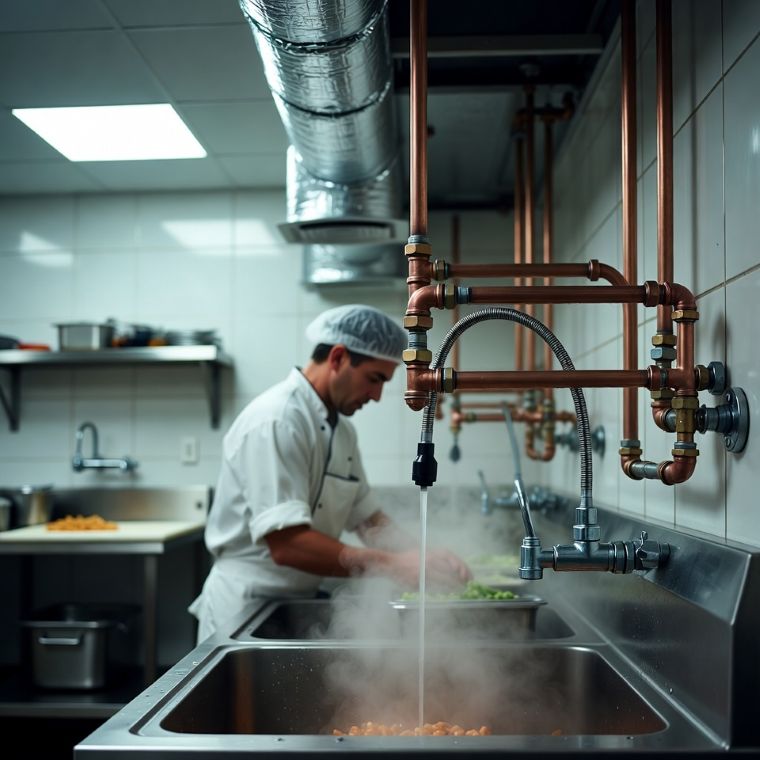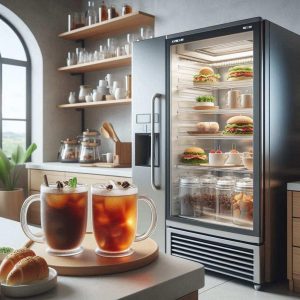
Food service operations depend on a steady flow of hot water, clean air, and controlled temperatures to keep dishes safe and customers happy. Every kitchen, from a small café to a large restaurant, relies on careful coordination between plumbing systems and HVAC units. These two systems shape everything from prep work to sanitation, and they also help staff maintain a safe and productive workspace.
A well designed kitchen needs both reliable water systems and stable heating and cooling to meet daily demands. Many restaurants work with specialists like Frederick MD HVAC professionals to set up temperature control that supports food safety rules and smooth operations. When both systems perform well, kitchens avoid delays, spoilage, and unnecessary stress on staff.
1. Strong Plumbing Supports Safe Food Prep
Food prep areas rely on clean, steady water at the right temperature. Sinks, cutting stations, and handwashing zones need dependable plumbing to stay sanitary. When water pressure is unstable or heaters fail, food safety becomes harder to manage. Proper plumbing ensures that every chef has what they need to prepare ingredients safely and efficiently.
2. Water Heaters Power Daily Sanitation
Dishwashing depends on water heaters that meet strict health code temperatures. Hot water helps remove grease and sanitize surfaces. If heaters fall behind or run too small for the kitchen size, dishes take longer to clean and bacteria become harder to eliminate. Regular inspections and right sized equipment reduce these problems.
3. Drainage Protects Floors and Work Zones
Good drainage keeps floors dry and reduces slip hazards. When drains clog or back up, water can spread across work areas and create contamination risks. Smooth drainage flow helps kitchens maintain a clean environment even during peak hours. This simple detail often makes a big difference in safe operations.
4. HVAC Controls Humidity in Storage Rooms
Humidity is one of the silent threats to stored ingredients. Too much moisture speeds up spoilage, molds, and changes in food quality. HVAC systems, especially high quality ventilation units, help keep cooler rooms and dry storage spaces at ideal conditions. This level of stability supports better storage technology, and resources like how vacuum insulating glass is changing the way we store and serve food and drink give more insight into how controlled environments keep ingredients fresh.
5. Air Circulation Helps Maintain Consistent Temperatures
A strong ventilation setup prevents hot and cold pockets inside the kitchen. Uneven temperatures can affect how ingredients are stored and how staff move around the workspace. Improved air circulation also helps remove heat from cooking equipment, making the entire kitchen safer and more comfortable.
6. Emergency Backup Systems Keep Work Moving
Backup heating and hot water systems protect operations during sudden failures. A broken water heater or HVAC unit can bring service to a halt. Kitchens that have emergency backups stay open even when something goes wrong. A backup system ensures that sanitation and dishwashing continue without delays.
7. Maintaining HVAC Is Key to Food Quality
Well maintained HVAC systems support consistent temperatures for coolers, prep tables, and walk in units. When HVAC systems work smoothly, chefs can trust that ingredients stay fresh. Routine checkups from technicians, including services similar to those offered by Frederick MD HVAC, help prevent breakdowns during busy shifts.
8. Plumbing and HVAC Work Together for Energy Savings
Efficient hot water systems and updated heating or cooling units lower utility costs. Modern commercial kitchens use a large amount of energy each day. Choosing efficient water heaters, paired with upgraded HVAC units, reduces long term operating expenses. Energy savings often come from small but smart upgrades.
9. Combined Upgrades Improve Staff Comfort
A kitchen with good airflow and easy access to hot water supports faster and safer teamwork. Staff move quickly, handle high heat, and work during long shifts. When both systems work well, the kitchen becomes more comfortable, organized, and productive. Comfort plays a major role in consistent food quality.
Conclusion
A kitchen functions best when plumbing and HVAC systems support each other. Clean water, stable temperatures, and strong airflow help maintain food safety and smooth workflow. Restaurants that work with reliable providers like Frederick MD HVAC manage equipment challenges faster and prevent health code issues. When plumbing and HVAC stay in sync, kitchens deliver better food, better safety, and a better working experience for everyone.










 Coffee and beer have inspired more than just morning rituals and weekend hangouts—they’ve inspired art on skin. For many men, tattoos of their favorite drinks symbolize far more than taste. They tell stories of relaxation, friendship, and the quiet moments that define their days. A steaming cup of espresso, a foamy pint of craft beer, or even a whiskey tumbler etched in ink can capture life’s simplest pleasures in a lasting way.
Coffee and beer have inspired more than just morning rituals and weekend hangouts—they’ve inspired art on skin. For many men, tattoos of their favorite drinks symbolize far more than taste. They tell stories of relaxation, friendship, and the quiet moments that define their days. A steaming cup of espresso, a foamy pint of craft beer, or even a whiskey tumbler etched in ink can capture life’s simplest pleasures in a lasting way.
 More than 60% of diners now browse menus online before deciding where to eat. This shift has transformed how people discover and enjoy food, making centralized restaurant and menu directories more valuable than ever. These platforms bring together essential information like delivery options, reviews, and reservations into one easy-to-use hub. For food lovers, it’s like having a digital food court at their fingertips.
More than 60% of diners now browse menus online before deciding where to eat. This shift has transformed how people discover and enjoy food, making centralized restaurant and menu directories more valuable than ever. These platforms bring together essential information like delivery options, reviews, and reservations into one easy-to-use hub. For food lovers, it’s like having a digital food court at their fingertips. Outdoor dining has become a
Outdoor dining has become a  Food and furniture don’t always mix well. Crumbs, spills, and stains often find their way onto couches and chairs, especially in homes where meals are enjoyed near living spaces. Keeping upholstery clean in these areas takes effort, but it’s entirely possible with the right approach. By using smart cleaning solutions and a bit of know-how, you can maintain fresh, inviting furniture no matter how close it is to the kitchen or dining table.Regular maintenance is the key to preventing messes from settling in. For instance, vacuuming your upholstery weekly removes dust, crumbs, and pet hair before they become embedded. A handheld vacuum works wonders for quick cleanups after meals. Additionally, spot-cleaning small spills immediately can stop stains from setting. For effective spot-cleaning, professionals like those at https://upholsterycleaningbrisbane.com.au recommend using a mild detergent mixed with water and a soft cloth. Blot the stain gently—never rub, as this can push the mess deeper into the fabric.
Food and furniture don’t always mix well. Crumbs, spills, and stains often find their way onto couches and chairs, especially in homes where meals are enjoyed near living spaces. Keeping upholstery clean in these areas takes effort, but it’s entirely possible with the right approach. By using smart cleaning solutions and a bit of know-how, you can maintain fresh, inviting furniture no matter how close it is to the kitchen or dining table.Regular maintenance is the key to preventing messes from settling in. For instance, vacuuming your upholstery weekly removes dust, crumbs, and pet hair before they become embedded. A handheld vacuum works wonders for quick cleanups after meals. Additionally, spot-cleaning small spills immediately can stop stains from setting. For effective spot-cleaning, professionals like those at https://upholsterycleaningbrisbane.com.au recommend using a mild detergent mixed with water and a soft cloth. Blot the stain gently—never rub, as this can push the mess deeper into the fabric.
 Not all cleaning solutions are created equal. Harsh chemicals can damage delicate fabrics, while ineffective products leave stains untouched. Opt for upholstery-safe cleaners that are free of bleach or strong solvents. A mixture of white vinegar and water works well for minor stains and odors. For tougher messes, consider enzyme-based cleaners that break down organic matter like food or grease. Always test any product on a hidden area first to avoid discoloration. Curious about which cleaner suits your furniture? Check the care label on your upholstery for guidance.
Not all cleaning solutions are created equal. Harsh chemicals can damage delicate fabrics, while ineffective products leave stains untouched. Opt for upholstery-safe cleaners that are free of bleach or strong solvents. A mixture of white vinegar and water works well for minor stains and odors. For tougher messes, consider enzyme-based cleaners that break down organic matter like food or grease. Always test any product on a hidden area first to avoid discoloration. Curious about which cleaner suits your furniture? Check the care label on your upholstery for guidance. Sometimes, DIY methods aren’t enough. Deep-set stains, lingering odors, or delicate fabrics may require expert care. Professional upholstery cleaners have specialized tools and solutions to tackle tough messes without harming your furniture. They can also apply protective treatments to extend the life of your upholstery. Scheduling a professional cleaning once or twice a year keeps your furniture in top shape, especially in high-traffic areas near the kitchen.
Sometimes, DIY methods aren’t enough. Deep-set stains, lingering odors, or delicate fabrics may require expert care. Professional upholstery cleaners have specialized tools and solutions to tackle tough messes without harming your furniture. They can also apply protective treatments to extend the life of your upholstery. Scheduling a professional cleaning once or twice a year keeps your furniture in top shape, especially in high-traffic areas near the kitchen. Lung health is often overlooked in discussions about nutrition, but what you eat and drink can significantly impact your respiratory system. A balanced diet can help reduce inflammation, improve lung function, and even combat the effects of environmental pollutants.
Lung health is often overlooked in discussions about nutrition, but what you eat and drink can significantly impact your respiratory system. A balanced diet can help reduce inflammation, improve lung function, and even combat the effects of environmental pollutants.
 As a restaurant owner, it’s essential to distinguish your business in a crowded and fiercely competitive industry. A well-designed website can help you do just that. In today’s digital age, having an attractive and functional website is essential for any restaurant that wants to attract and retain customers. Check the web design service of www.dogoodthings.co.nz/web-design-wellington. In this article, we’ll explore the impact of good web design on the success of your restaurant business.
As a restaurant owner, it’s essential to distinguish your business in a crowded and fiercely competitive industry. A well-designed website can help you do just that. In today’s digital age, having an attractive and functional website is essential for any restaurant that wants to attract and retain customers. Check the web design service of www.dogoodthings.co.nz/web-design-wellington. In this article, we’ll explore the impact of good web design on the success of your restaurant business.
 The pandemic of 2020 saw the food truck business evolving into a highly profitable food and drinks retail sector seen as safer alternatives to
The pandemic of 2020 saw the food truck business evolving into a highly profitable food and drinks retail sector seen as safer alternatives to  A food truck usually uses a single unit, denoting that unlike a food trailer, the cooking and selling areas are not being towed by another vehicle.
A food truck usually uses a single unit, denoting that unlike a food trailer, the cooking and selling areas are not being towed by another vehicle.

 Running a food truck business has been on the rise since 2008 and is one of the quickest-developing establishments in the industry of
Running a food truck business has been on the rise since 2008 and is one of the quickest-developing establishments in the industry of  Quick Response Time
Quick Response Time
 Vacuum insulating glass (VIG) is becoming more popular not just in construction, but also in the food and beverage world. Its ability to maintain temperatures, whether hot or cold, has made it a super glass and useful in many everyday products. From wine glasses to restaurant windows, this type of glass can help improve how food and drinks are stored, served, and enjoyed. Learn how it’s also transforming architecture and green building at the vacuum-glass(.com) website.
Vacuum insulating glass (VIG) is becoming more popular not just in construction, but also in the food and beverage world. Its ability to maintain temperatures, whether hot or cold, has made it a super glass and useful in many everyday products. From wine glasses to restaurant windows, this type of glass can help improve how food and drinks are stored, served, and enjoyed. Learn how it’s also transforming architecture and green building at the vacuum-glass(.com) website.







 by some unruly
by some unruly  In addition to CCTVs, venues that expect to draw a massive number of people, will have to have crowd control strategies and equipment for preventing crowd surges.
In addition to CCTVs, venues that expect to draw a massive number of people, will have to have crowd control strategies and equipment for preventing crowd surges.





 Almost all fish and other marine life are edible, but not all are eaten raw. Raw fish has been fashionable in the West for some time, but sushi and sashimi have been part of Japanese cuisine for centuries. If you’re preparing both at home, follow their lead.
Almost all fish and other marine life are edible, but not all are eaten raw. Raw fish has been fashionable in the West for some time, but sushi and sashimi have been part of Japanese cuisine for centuries. If you’re preparing both at home, follow their lead.


 Food production is a multi-faceted process that goes beyond actual cooking and cooking to include all facility operations, business practices, and supply chains. And, of course, the COVID 19 pandemic poses a unique set of challenges. Food processing efficiency remains important for profitability, as manufacturers strive to maximize both food quality and production. Leading manufacturers take a
Food production is a multi-faceted process that goes beyond actual cooking and cooking to include all facility operations, business practices, and supply chains. And, of course, the COVID 19 pandemic poses a unique set of challenges. Food processing efficiency remains important for profitability, as manufacturers strive to maximize both food quality and production. Leading manufacturers take a 